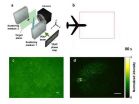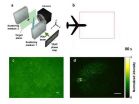(Press-News.org) As a child, it was fascinating to put a flashlight up to our palms to see the light shine through the hand. Washington University in St. Louis engineers are using a similar idea to track movement inside the body's tissues to improve imaging of cancerous tissues and to develop potential treatments.
Lihong Wang, PhD, the Gene K. Beare Distinguished Professor of Biomedical Engineering at the School of Engineering & Applied Science is applying a novel time-reversal technology that allows researchers to better focus light in tissue, such as muscles and organs.
Current high-resolution optical imaging technology allows researchers to see about 1 millimeter deep into the body. Beyond that, the light scatters and obscures the features, which is why we can't see bones or tissue in the hand with a flashlight. To overcome this, Wang and his lab developed photoacoustic imaging, which combines light with acoustic waves, or sound, to form a sharper image, even several centimeters into the skin.
In new research published Nov. 2 in Nature Photonics Advance Online Edition, Wang is now using a new technology called time-reversed adapted-perturbation (TRAP) optical focusing, which sends guiding light into tissue to seek movement. The light that has traversed stationary tissue appears differently than light that has moved through something moving, such as blood. By taking two successive images, they can subtract the light through stationary tissue, retaining only the scattered light due to motion. Then, they send that light back to its original source via a process called time-reversal so that it becomes focused once back in the tissue.
VIDEO:
This video shows dynamic focusing onto a moving target inside scattering media.
Click here for more information.
"This can potentially be used in imaging or therapy," Wang says. "For example, focusing pulsed light on port wine stains, which are excessive growth of blood vessels, could remove the stains without damaging the surrounding normal skin."
In 2011, Wang's lab was the first to use ultrasound focusing to provide a virtual, non-invasive internal guide star that allowed them to focus on anything moving in tissue. But TRAP focusing is much more efficient in tracking moving targets, Wang says in the new research. TRAP focusing can enhance and contrast by redistributing and concentrating light on the targets, allowing for images to be taken from greater depths.
Wang, an internationally renowned expert in photoacoustic imaging, is or has been principal investigator on 37 research grants with a cumulative budget of $47 million. Most recently, he received a prestigious three-year, $2.7 million BRAIN Initiative Award from the National Institutes of Health and the 2015 Britton Chance Biomedical Optics Award from SPIE for his pioneering technical contributions and visionary leadership in the development and application of photoacoustic tomography, photoacoustic microscopy and photon transport modeling. He also has received the NIH FIRST and the NIH Director's Pioneer awards as well as the National Science Foundation CAREER Award.
INFORMATION:
The School of Engineering & Applied Science at Washington University in St. Louis focuses intellectual efforts through a new convergence paradigm and builds on strengths, particularly as applied to medicine and health, energy and environment, entrepreneurship and security. With 91 tenured/tenure-track and 40 additional full-time faculty, 1,300 undergraduate students, more than 900 graduate students and more than 23,000 alumni, we are working to leverage our partnerships with academic and industry partners — across disciplines and across the world — to contribute to solving the greatest global challenges of the 21st century.
Ma C, Xu X, Liu Y, Wang LV. Time-reversed adapted perturbation (TRAP) optical focusing onto dynamic objects inside scattering media. Nature Photonics Advanced Online Edition, Nov. 2, 2014. DOI: 10.1038/nphoton.2014.251.
Funding for this research was provided by the National Institutes of Health grants DP1 EB016986 and R01 CA186567.
Improving imaging of cancerous tissues by reversing time
2014-11-02
ELSE PRESS RELEASES FROM THIS DATE:
Mutant models
2014-11-02
Nate Silver and Richard Feynman walk into a bar and bump into a biologist . . .
While this may sound like the setup to some late-night nerd sketch, researchers have taken this premise and applied it to an increasingly cumbersome problem in modern biology, namely, finding meaning in the rising oceans of genomic data.
In this specific instance, the data comprisesreams of cancer mutations that genome-wide studies are publishing at a dizzying rate. The challenge is finding new and efficient ways to parse the signal from the noise (and there is no shortage of noise).
As ...
Ultracold disappearing act
2014-11-02
A disappearing act was the last thing Rice University physicist Randy Hulet expected to see in his ultracold atomic experiments, but that is what he and his students produced by colliding pairs of Bose Einstein condensates (BECs) that were prepared in special states called solitons.
Hulet's team documented the strange phenomenon in a new study published online this week in the journal Nature Physics.
BECs are clumps of a few hundred thousand lithium atoms that are cooled to within one-millionth of a degree above absolute zero, a temperature so cold that the atoms march ...
New technique efficiently turns antibodies into highly tuned 'nanobodies'
2014-11-02
Antibodies, in charge of recognizing and homing in on molecular targets, are among the most useful tools in biology and medicine. Nanobodies – antibodies' tiny cousins – can do the same tasks, for example marking molecules for research or flagging diseased cells for destruction. But, thanks to their comparative simplicity nanobodies offer the tantalizing prospect of being much easier to produce.
Unfortunately, their promise hasn't been fully realized, because scientists have lacked an efficient way of identifying the nanobodies most closely tuned to their ...
'Invisible tattoos' could improve body confidence after breast cancer radiotherapy
2014-11-02
Invisible tattoos could replace the permanent dark ink tattoos used to ensure that breast cancer patients having radiotherapy are treated in exactly the same spot during each session, according to results from a pilot study to be presented at the National Cancer Research Institute (NCRI) Cancer Conference today (Sunday)*.
Research suggests that the permanent pin prick marks made on the skin of women having radiotherapy reminds them of their diagnosis for years to come, reducing body confidence and self-esteem.
It's also more difficult to spot these tattoos in dark-skinned ...
Step towards blood test for many cancer types
2014-11-02
Scientists have identified more than 800 markers in the blood of cancer patients that could help lead to a single blood test for early detection of many types of cancer in future, according to research presented at the National Cancer Research Institute (NCRI) Cancer Conference in Liverpool today (Sunday).
This is the first time that cancer-specific blood markers have been comprehensively reviewed and identified for further clinical development. This study, by the UK Early Cancer Detection Consortium*, funded by Cancer Research UK, has analysed 19,000 scientific papers ...
JNS: Pediatrics publishes guidelines for the treatment of pediatric hydrocephalus
2014-11-01
Charlottesville, VA (November 1, 2014). The Journal of Neurosurgery Publishing Group is pleased to announce today's publication of "Pediatric hydrocephalus: systematic literature review and evidence-based guidelines," a supplement to the November issue of the Journal of Neurosurgery: Pediatrics. Authored by a volunteer task force from the pediatric neurosurgery community, the supplement offers a thorough evaluation of the current treatments for pediatric hydrocephalus as well as up-to-date evidence-based recommendations for their use.
Hydrocephalus is a condition in which ...
More penalties on the way for hospitals that treat the poor? New U-M study suggests so
2014-11-01
ANN ARBOR, Mich. – Last week, the federal government revealed that it will fine more than 2,600 hospitals in the coming year, because too many Medicare patients treated at these hospitals are ending up back in the hospital within 30 days of going home. Two new conditions have been added in this round of penalties: elective hip and knee replacement and chronic lung disease.
Now, a new University of Michigan analysis shows that penalties for chronic lung disease will have a greater impact on hospitals that care for poor and minority patients. The findings are published ...
Cancer cell fingerprints in the blood may speed up childhood cancer diagnosis
2014-11-01
Newly-identified cancer cell fingerprints in the blood could one day help doctors diagnose a range of children's cancers faster and more accurately, according to research* presented at the National Cancer Research Institute (NCRI) Cancer Conference next week.
The researchers, from the University of Cambridge and Addenbrooke's Hospital in Cambridge, found unique molecular fingerprints for 11 types of children's tumours,** which could be used to develop blood tests to diagnose these cancers.
This may eventually lead to a quicker, more accurate way to diagnose tumours, ...
Study of Chile earthquake finds new rock structure that affects earthquake rupture
2014-11-01
Researchers from the University of Liverpool have found an unusual mass of rock deep in the active fault line beneath Chile which influenced the rupture size of a massive earthquake that struck the region in 2010.
The geological structure, which was not previously known about, is unusually dense and large for this depth in the Earth's crust. The body was revealed using 3-D seismic images of Earth's interior based on the monitoring of vibrations on the Pacific seafloor caused by aftershocks from the magnitude 8.8 Chile earthquake. This imaging works in a similar way to ...
Breaking down DNA by genome
2014-10-31
New DNA sequencing technologies have greatly advanced genomic and metagenomic studies in plant biology. Scientists can readily obtain extensive genetic information for any plant species of interest, at a relatively low cost, rapidly accelerating the pace of genome sequencing.
However, since plant tissues harbor three separate genomes (nuclear, chloroplast, and mitochondrial), it can often be challenging to isolate the particular genome of interest from extracted DNA samples. Sequencing DNA containing all three genomes therefore results in a considerable amount of wasted ...




